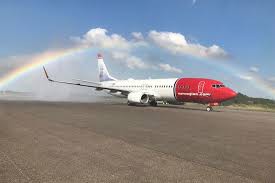The first Norwegian Air flight from London to Argentina landed at Ezeiza International Airport on Thursday, marking a successful “take-off” in Latin America for Europe’s third largest low-cost airline.
The 787 Dreamliner flight landed in the Argentine capital from London Gatwick. It was met in Buenos Aires by Transport Minister Guillermo Dietrich, UK Ambassador to Argentina Mark Kent, Tourism Minister Gustavo Santos and Aeropuertos 2000 chief Martín Eurnekian.
The flight marks the UK’s first low-cost route to South America and Norwegian’s arrival is the latest addition to an aviation market that is rapidly changing.
The début of the first low-cost airline in Argentina, Flybondi, last month opened up a new chapter for the local aviation market, which has yet to clear the structural obstacles of a historically neglected industry.
In Argentina just 25 out of every 100 people fly, less than half than in Chile (56) and also – according to the Administración Nacional de Aviación Civil Argentina (ANAC) – below the percentages in Brazil, Colombia and Peru, which offer more open skies and routes.
Between 2000 and 2015, the Argentine aviation market grew 21 percent in terms of passengers while in the same period Chile, Brazil, Colombia and Peru expanded by an average of 186 percent, according to the ANAC.
Argentina “has suffered a deficit of supply due to regulatory policies which have made flying unviable and unprofitable,” Carlos Ozores, consultant to the US company ICF, told the AFP news agency.
Argentina is now hoping to follow in the footsetps of Brazil, Colombia, Mexico, Panama, Chile and Peru, after the arrival of low-cost options in those countries.
CHANGE OF COURSE
Soon after taking office in 2015, President Mauricio Macri embarked on a change of course – it opened up the industry to competition and gave a green light to new operators, some low cost and others conventional.
Last January the domestic market – dominated up to almost 80 percent by Aerolíneas Argentinas, followed by Chile’s LATAM with less than 20 percent and a handful of other companies – saw the entry of Flybondi and a total of 85 routes were assigned to low-cost airlines, both local and international. Norwegian has now followed in its tracks, with more options lining up on the horizon.
The delay in the development of the Argentine market is also the main attraction for the entry of new players.
“What they see in this backward niche is an enormous opportunity,” José Barbero, dean of the Transport Institute of San Martín University, told this agency.
The supply deficit “has translated into very slow growth for traffic, especially given this country’s size and population,” said Ozores, referring to Argentina’s total area of 2.78 million square kilometres (the eighth largest country in the world) and population of 42 million. Up until now, in a country with limited air connectivity road travel has prevailed.
“Argentina sells around 70 million tickets a year for land travel but not more than 14 million by air,” said aviation specialist Franco Rinaldi.
The government’s aim is for domestic flights to double the number of passengers by 2019, Macri announced when presenting his national aviation plan in March, 2017. And de-regulating the skies is not enough to achieve that aim.
GOVERNMENT THE KEY
Barbero warns of the “limited capacities of the airports for the various functions they must serve: passengers, aircraft, land access, etc.”
“Opening up this way requires a more complete strategy, due to the multiple impacts on airport infrastructure and support for aviation,” he stressed.
As an alternative to the main airports and to absorb the expected increased demand, the government opted to grant commercial use to the El Palomar Air Force base – located in the outskirts of Buenos Aires – so that low-cost companies can operate there. The decision was not free of controversy: local residents complained of the environmental impact which the move might have, while various human rights organisations objected to the project due to memories of its association with the last military dictatorship (1976-1983).
“Most of the Argentine airport system has been destroyed by all those years without investment,” Rinaldi warned.
